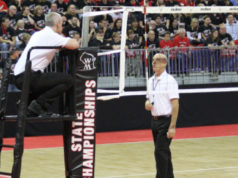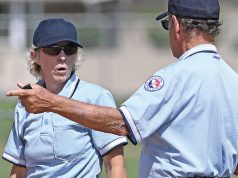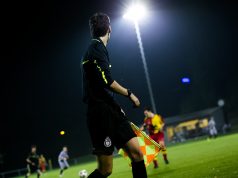
“What’s My Line?” was a popular TV game show 45 years ago. Larry Blyden was the host and the premise was that four celebrities had to guess a contestant’s unusual occupation by asking yes-or-no questions. Occasionally, there was time left to fill at the end of the show, so they played Who’s Who? Four people would be selected from the studio audience, their occupations written on cards and the panel would take turns trying to match the right people with the right occupation — on looks alone. Being 1970, they seldom guessed that the woman was the airline pilot or the guy was the stenographer.
If they played Who’s Who? today, what would happen if the four were sport officials? Would Arlene Francis or Soupy Sales ever be able to tell a football, basketball, soccer and volleyball official apart? It would be a challenge, wouldn’t it? Back then, it might have been easier: The football official would be the ripped-looking, middle-aged guy; the basketball referee a little whippet of a man; the soccer referee ethnic-looking and the volleyball official the only woman in the group. OK, so the evolution of officiating has banished a lot of stereotypes; does that mean that any person could work any sport? Do some sports require certain skills that are unnecessary in others? Maybe there’s a core set of abilities common to all successful officials but they emphasize certain ones over others, according to the sport they’re working.
Who’s best at what in officiating?
Ken Kaylor is an orthopedic surgeon who has run 27 marathons in his life. He took up soccer refereeing about eight years ago. As he puts it, he was “mad at the high school officials,” for the low standard of fitness they brought to the sport, and he knew he could do better. Today, he is director of fitness for the National Intercollegiate Soccer Officials Association (NISOA) and has some definite opinions both on what makes officials tick and what soccer referees can teach the rest of us.
He describes officiating skills as a triangle of didactic knowledge, values and psychomotor skills, subdividing psychomotor skills into fitness and mechanics. Didactic knowledge is the rules and case knowledge necessary to judge a sport competently. Values are the elements of the “it” factor necessary to manage the game successfully while fitness and mechanics are the tools to make the other things work. In Kaylor’s estimation, many sports get by with two sides of the triangle, but soccer requires all three, with fitness being the most underestimated.
“We probably don’t spend enough time discussing the psychomotor skills sets,” Kaylor said. “As a soccer official you have to get your values squared away — you’re willing to make the tough calls; you’re not going to do things that make you look bad; you’re not going to give people the opportunity to perceive you as other than what you are. You’ve also got to get your psychomotor skills down and then you’ve got the didactics.
“We spend a little too much time on the hard didactics and not enough building the other two sides of that triangle.”
Soccer, at the highest levels, measures officials’ fitness with variants of the so-called FIFA fitness test. Hockey and rugby also qualify officials by a fitness test. Kaylor said it’s still too easy to pass the soccer test — even at the state and national levels. In his NISOA role, he has implemented a new test for 2015. It’s more of a series of time trials, which he says requires more appropriate physical conditioning. In his view, the same type of test would be appropriate in many sports, offering the NFL as a good place to start.
NFL officials need to be up to the rigors of no-huddle offenses, like the pros often run: The teams can run in fresh substitutes in the prime of their physical fitness, play-after-play, while seven 40- and 50-somethings constantly endeavor to call the play — spot the ball — repeat, with no respite.
Jerome Boger is an NFL referee and knows what Kaylor is talking about. NFL officials constantly work at conditioning to be able to work as long as possible in the league. As offenses evolve, it’s a battle that’s getting harder to win.
Notwithstanding the fitness requirements, Boger said it’s game management skills that make football officials stand out. He says the NFL has set the tone for sports officials making a call and then getting together to validate it. That’s done either as a group or through the use of replay, while the effect on the game of an initial error can still be corrected.
“In other sports,” explained Boger, “you see, you call, and there’s no real intervention from your partners about what happened on the play.” With seven officials on the field, he says, there’s often going to be another official with a different angle who will have a better look at a foul, making ownership of critical calls more of a team proposition.
Boger got his officiating start working high school basketball, baseball and football. He believes the sport that best prepares a person to work with others is basketball. That’s because of the environment of making frequent, challenging calls with the beneficiaries/victims of your decisions within cursing distance. Learning to work basketball boils down to repetition combined with responding to, and learning to manage, the emotions of the sport. You can figure out early on in your career whether you’re cut out for officiating.
Larry Spaulding is a 22-year Division I men’s basketball official who has worked seven NCAA tournaments. He agreed with Boger’s assessment. “You have to deal with plays that are happening so quickly without the benefit of seeing them over again (as in football),” Spaulding said. “You have to make instantaneous decisions, so I think you get used to seeing a play and making a quick judgment on it. … We have the players, the coaches and fans right on top of you.”
Unless replay is provided in some situations at some levels, the basketball people have to live with their calls on the court, he added, so they’ve learned to exploit the use of game video to review their work between games — even between halves — and refine their judgments. That’s something that the football officials really started.
Spaulding said another thing basketball officials are strong at is looking after their bodies. The huge numbers of games they could work in a four-month season can take a huge toll otherwise.
Physical preparation and nutrition management is then a year-round activity for Spaulding, not something to start doing when the leaves turn color. He thinks officials in any other sport — even less strenuous ones — can perform better and last longer by emulating that approach.
Spaulding also said that basketball officials at various levels often work with many different partners. It isn’t unusual to work with people you’re unfamiliar with, so there’s no room for crewmates improvising on mechanics; one unexpected action or inaction at the wrong time can send the crew down in flames.
Steve McCown believes softball umpires lead the way in standardizing mechanics and taking the guesswork out of game management and play coverage. McCown has worked the College World Series as well as two World Cups, but also works high school basketball in his offseason.
“The other night I was working a basketball game and had reported a foul to the table. I turned around and saw the center official pointing at me like he was shooting a gun,” McCown recalled. That puzzled McCown because he didn’t think it was that bad of a call. Then he realized his partner was simply alerting him that a substitute for the shooter was waiting at the table, in case the free throw was made. Working a game is the wrong place for playing charades.
McCown recalled a time early in his career when his softball crew chief advised him during their pregame to pay attention to which hand he pointed with if he asked for help on a checked swing. “If I come to you with my right hand, I don’t want you to change my call. If I use my left hand, I don’t know what I had,” was the explanation. He believes that softball has acted wisely to eliminate the turmoil that going off the menu was causing.
“We’re not at liberty to do anything different except on our third strike signal,” McCown explained. If umpires all look and behave the same, then teams and fans have more confidence that the game is being called consistently. Nevertheless, he has many very capable acquaintances who aren’t progressing because they haven’t bought in to that universality, he said. “In my opinion,” McCown said, “adhering to the manual makes it better (for the sport). If you don’t want to buy into the philosophy — and there are those that don’t — you don’t work postseason anymore.”
Of all the major team sports, volleyball requires more decisions by the referee than any other. Katy Meyer should know; she’s deputy executive director of the Professional Association of Volleyball Officials (PAVO). Meyer has an international rating in beach volleyball as well as being an NCAA and USA Volleyball indoor official.
“Cognitively, one of the things that separates volleyball referees from not all other sports, but many other sports, is just how many decisions are being made during the course of a single play,” said Meyer. “In a single rally, there can be tens to dozens of decisions that get made. “Then, over the course of a set and a match, that’s hundreds of decisions. Over the course of a single day in a tournament, that can be thousands of decisions to be made.”
Working home plate in baseball or softball may require 200-300 ball/ strike decisions per game, but there’s breathing room between each call. Refereeing volleyball, meanwhile, is more like running a hurdles race because there’s no time to look back and second-guess; you have to keep looking ahead and persevering. Consistently calling ballhandling fouls, tips, net violations and the like involves equal measures of nimble, spacial memory and confidence. Both of those can erode if you start reliving contentious decisions instead of staying in the present. It takes hours of concentration in a competitive and emotional environment that can be every bit as intense as a basketball or hockey game.
Meyer said the complicating factor for volleyball officials is the static position the first referee (R1) has on the platform. Unlike almost any other sport, where the official can work to get toward the best angle to see the play, she said, “You can’t get up high enough, or down low or off to the side all the time,” to be in the right position to make a good guess. R1 really has to have a unique gift of split-second pattern recognition to keep the confidence of the coaches and players: You don’t always see the play, but you know what happened, through experience. While working a volleyball match isn’t a lot of exercise for volleyball officials, she says the best are always in excellent physical condition in order to remain focused as a tight game wears on.
Volleyball has also specialized officials’ duties to a degree rivaling any sport. We’ve talked about the hundreds of decisions the quasi-automaton R1 makes, without giving the second referee, R2, his or her due. R2 is responsible for managing the scorer’s table, benches, coaches and play along the net. Sounds simple enough, but R1 is usually insulated from all the fun across the floor. R2’s domain is dealing with the sweet nothings uttered by coaches and solving the crossword puzzle known as the libero tracking sheet. It doesn’t call for much whistle blowing, but is indispensable to a smooth game.
Let us review: Kaylor’s didactic triangle, Meyer’s use of the brain’s frontal lobes and McCown’s focus on standard mechanical rubrics — they make officiating sound more like a job for Bill Nye the Science Guy.
Maybe it’s true that every sport has something to learn from another. In addition, if you understand the specialized traits of officials in your sport, you can improve your ability to retain them. You’ll do it by becoming more sophisticated at finding and developing the right matches for your needs and helping them mature. That might sound like striped eugenics to some people but, to officials, it’s nothing more than getting more help finding our way as we develop. Just ask Mara Wager.
Wager is a three-sport NCAA official in volleyball, basketball and lacrosse, as well as being a New York school teacher. She’s worked 10 Division I Final Fours in lacrosse, the Division III Final Four in basketball and Division I and III Final Fours in volleyball. That’s not the interesting part, though; it’s the path she took to get there.
“I’ve been able to take very specific elements from each of those three sports and carry them on,” Wager said. “I would not have been able to work at the level I’m working in women’s lacrosse if I hadn’t worked sports like Division I women’s basketball and volleyball. The work that goes into signals and mechanics and communication in both of those sports made women’s lacrosse easy for me: I was never a lacrosse player.
“Lacrosse was the last sport that I took up officiating, but it was the first one where I called a Division I national championship.”
Wager explains that she developed some notoriety in basketball and volleyball and, when the college leagues needed more good lacrosse officials, they twisted her arm and she took the plunge. Somebody thought she might be up to it, so she might be living proof that officials are born and then can develop and broaden that innate skill set to meet new challenges. You should be prepared to let what you learn lead you to what you’re really best at. There is no failure in trying a sport and then giving it up for another; you find out something about yourself and can take something from your experience with that sport: everyone wins.
The message is that officials in any sport have special strengths — management, stamina, intelligence, judgment, resilience to pressure; to name a few — but don’t always realize how much they have until put to the test. Developing those strengths is called personal growth. Enjoy the experience.
What's Your Call? Leave a Comment:
Note: This article is archival in nature. Rules, interpretations, mechanics, philosophies and other information may or may not be correct for the current year.
This article is the copyright of ©Referee Enterprises, Inc., and may not be republished in whole or in part online, in print or in any capacity without expressed written permission from Referee. The article is made available for educational use by individuals.


















